Did you know that the Philippine Inquisition lasted for over 200 years? This lesser-known chapter of history reveals how the Catholic Church shaped colonial governance and public belief in the archipelago. Rooted in European religious practices, the inquisitorial system arrived in the Philippines during the Spanish colonial era.
The Catholic Church played a pivotal role in enforcing religious conformity. Through its procedures, it influenced local customs and governance. The inquisitorial process evolved, adapting to colonial policies and interacting with indigenous practices.
This section explores the historical context and long-term impact of these procedures. It highlights how Catholic authority shaped the Philippines, leaving a legacy that resonates even today.
Key Takeaways
- The Philippine Inquisition spanned over two centuries.
- It was rooted in European religious and judicial practices.
- The Catholic Church enforced religious conformity in the archipelago.
- Local customs and governance were deeply influenced by these procedures.
- The inquisitorial system adapted to colonial policies over time.
Introduction to the Inquisition in the Philippines
The Philippines experienced a unique blend of religious and judicial practices during the Spanish colonial era. Rooted in European traditions, the church played a central role in enforcing religious conformity. This system, adapted to local conditions, shaped the archipelago’s governance and culture.
Ecclesiastical courts were established to maintain religious orthodoxy. These courts operated under the authority of the church, ensuring adherence to Catholic doctrine. Historical records reveal detailed procedures and trials that highlight the system’s complexity.

The adaptation of European traditions in the Philippines was not without challenges. Local customs and practices often clashed with the imposed religious framework. Despite this, the system persisted, leaving a lasting impact on the archipelago’s history.
“The inquisitorial process was a tool of both religious and colonial control, shaping the Philippines in profound ways.”
This section sets the stage for a deeper exploration of the cultural, social, and legal impacts of these practices. Understanding this history provides valuable insights into the Philippines’ colonial past and its enduring legacy. For more on colonial influences, visit this detailed analysis.
Historical Context: The Expansion of the Spanish Inquisition
The Spanish Inquisition’s reach extended far beyond Spain, shaping religious and judicial practices across Europe and its colonies. Rooted in the Reconquista and the Catholic Church’s efforts to enforce orthodoxy, it became a tool of both religious and colonial control.
During the European Renaissance and Counter-Reformation, Spain’s religious policies aimed to unify its territories under Catholic doctrine. This ambition led to the establishment of inquisitorial tribunals not only in Spain but also in its overseas colonies. The forced conversions of Jews and Muslims during the Reconquista set a precedent for these practices.

Key events in Europe, such as the expulsion of Jews in 1492 and the suppression of Protestant movements, influenced the Inquisition’s methods. These policies were exported to the Americas and Asia, including the Philippines, where they adapted to local conditions.
“The Spanish Inquisition was not just a European phenomenon; it was a global force that reshaped societies across continents.”
By the 16th century, the Inquisition had become a cornerstone of Spain’s imperial strategy. Its tribunals operated in regions as diverse as the Low Countries, Portugal, and the Philippines, leaving a legacy that continues to be studied today.
Origins and Evolution of the Inquisition
The roots of the inquisitorial system trace back to medieval Europe, where religious dissent was met with strict measures. During this period, the Catholic Church sought to maintain orthodoxy by addressing challenges to its authority. Heresy became a primary concern, leading to the development of formal procedures to identify and punish heretics.
Medieval Foundations and Early Procedures
In the 12th century, the Church began to formalize its response to heresy. Pope Lucius III mandated bishops to conduct inquiries in their dioceses, marking the start of ecclesiastical trials. These early procedures were often informal, relying on local clergy to investigate and report suspected heretics.
By the 13th century, the process became more structured. Pope Gregory IX appointed Dominican and Franciscan friars as inquisitors, giving them authority to investigate and prosecute cases. This shift introduced a more systematic approach, blending religious and judicial functions.
Transition to a State-Controlled Tribunal
Over time, the inquisitorial system evolved from a purely ecclesiastical process to one influenced by state authority. Secular rulers began to collaborate with the Church, using the tribunals to consolidate power. This partnership allowed for the enforcement of religious conformity while advancing political agendas.
For example, in 1252, Pope Innocent IV authorized the use of torture to extract confessions from heretics. This marked a significant shift, as secular authorities became directly involved in the judicial process. The tribunals’ methods became harsher, setting precedents that would later influence colonial administrations.
| Period | Key Development | Impact |
|---|---|---|
| 12th Century | Bishops mandated to conduct heresy inquiries | Informal ecclesiastical trials began |
| 13th Century | Appointment of Dominican and Franciscan inquisitors | Structured judicial processes emerged |
| 1252 | Use of torture authorized | Secular involvement increased |
The evolution of these procedures highlights the Church’s adaptability in addressing dissent. From informal inquiries to state-controlled tribunals, the system left a lasting legacy that shaped religious and judicial practices for centuries.
Spanish Colonial Influence in the Philippines
Spanish colonial rule brought profound changes to the Philippines, shaping its governance and religious landscape. The Spanish kingdom extended its authority across the archipelago, implementing policies that blended European practices with local traditions. This period marked the beginning of a new era, where colonial administration and religious uniformity became intertwined.
The Spanish established permanent settlements in the Philippines starting in 1565. These settlements served as centers of colonial authority, enforcing laws and spreading Catholic orthodoxy. The encomienda system, which granted land and native laborers to Spanish settlers, played a key role in consolidating power. This system ensured that the kingdom’s influence reached even the most remote areas.
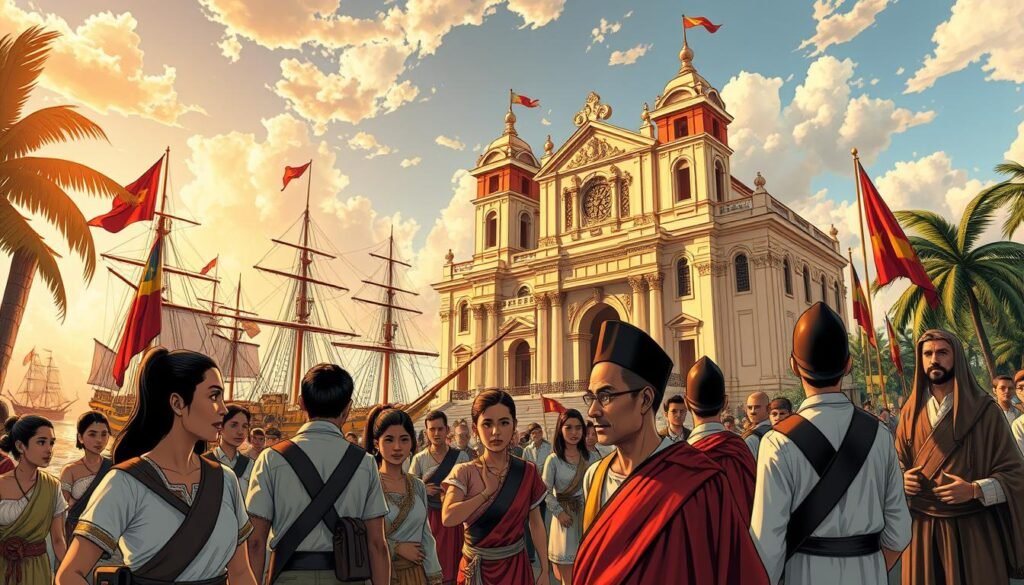
Colonial policies were driven by both political and religious motivations. The Spanish sought to unify the archipelago under Catholic doctrine, using the Church as a tool of control. Ecclesiastical courts were established to maintain religious conformity, often working in tandem with colonial administrators. This dual system of governance ensured that the kingdom’s authority was felt in every aspect of life.
“The Spanish colonial administration was not just about governance; it was a mission to reshape the Philippines in the image of the Catholic kingdom.”
The imposition of Catholic orthodoxy was a cornerstone of Spanish rule. Laws were enacted to suppress indigenous beliefs and practices, replacing them with European traditions. This process was not without resistance, but the Spanish authority persisted, leaving a legacy that continues to influence the Philippines today.
Colonial Administration and Religious Intolerance
Colonial administration in the Philippines was deeply intertwined with religious enforcement, shaping governance and public life. The Catholic Church played a central role in maintaining order, with bishops and high-ranking officials overseeing the implementation of religious conformity. This integration of church and state created a system where dissent was met with strict measures.
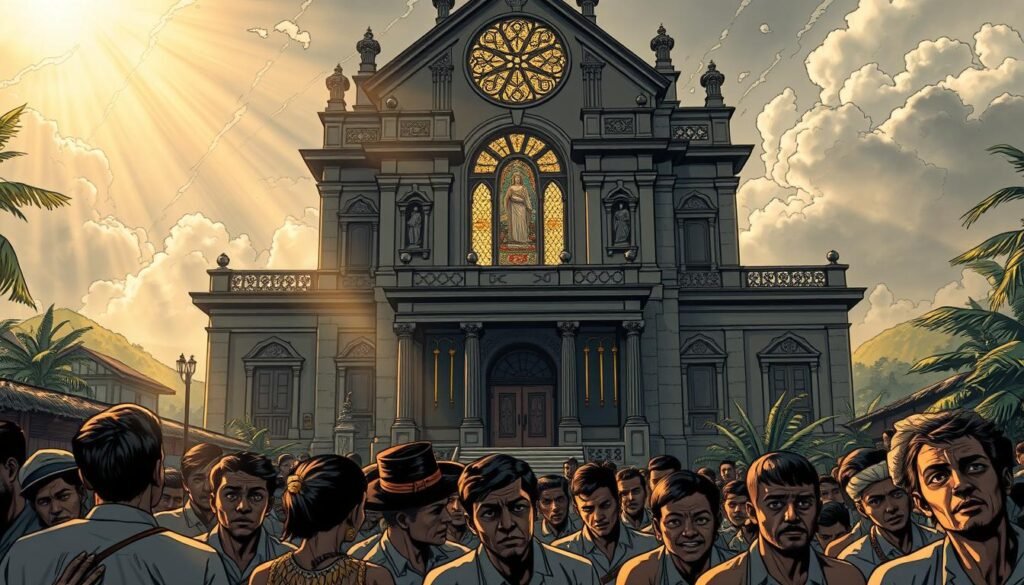
The Church’s Role in Governance
The church’s authority extended beyond spiritual matters, influencing colonial governance. Bishops held significant power, often working alongside Spanish officials to enforce laws. Their office became a cornerstone of the colonial system, ensuring that Catholic doctrine was upheld.
Ecclesiastical courts were established to address religious nonconformity. These courts operated under the authority of the church, with bishops presiding over trials. Their decisions often carried severe consequences, including excommunication or imprisonment.
Enforcement Strategies and Legal Measures
Enforcing religious conformity required a combination of legal measures and public displays of authority. Inquisitors, appointed by the church, acted as judicial agents. They investigated cases of heresy and apostasy, often using harsh methods to extract confessions.
Punishments ranged from public shaming to execution, serving as a deterrent to dissent. The Spanish crown supported these measures, viewing them as essential to maintaining control. Historical records highlight cases where individuals were tried and punished for challenging religious orthodoxy.
“The church’s role in governance was not just about faith; it was a tool of colonial control, shaping the Philippines’ social and legal landscape.”
This system of governance left a lasting impact on the Philippines, influencing its culture and legal framework for centuries. The integration of church and state during this period remains a significant chapter in the archipelago’s history.
Cultural and Social Impacts on Philippine Society
The cultural fabric of the Philippines was deeply altered by the enforcement of religious conformity. Fear of severe punishment and even death shaped the daily lives of Filipinos. This fear influenced social behavior, pushing many to outwardly adhere to Catholic practices while privately holding onto indigenous beliefs.
Family structures were also affected. The threat of inquisitorial trials created tension within households. Parents often warned children to avoid practices deemed heretical, fearing the consequences. This dynamic reshaped generational relationships, embedding caution into family traditions.
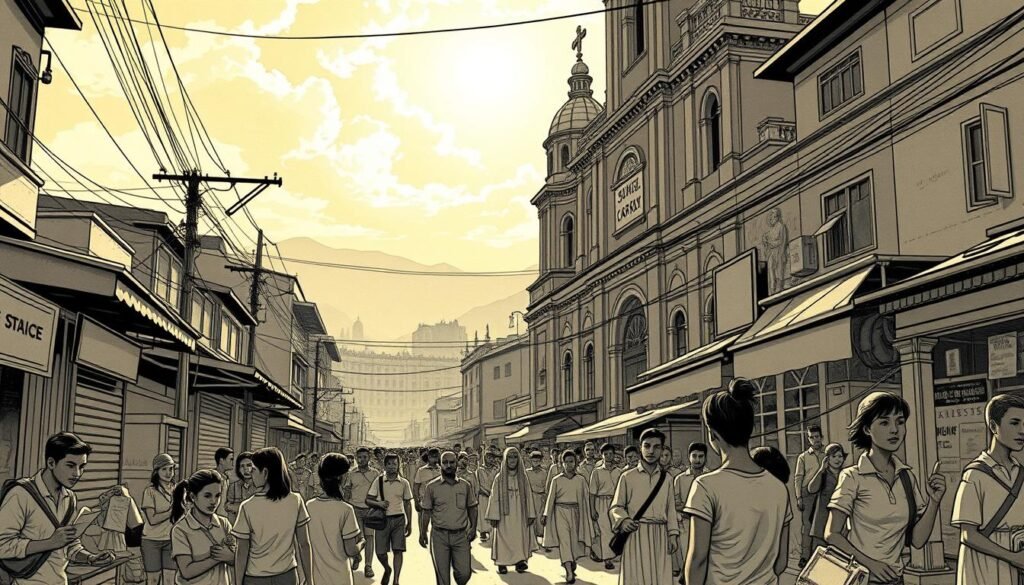
Community relations were similarly strained. Neighbors sometimes reported each other to avoid suspicion, fostering mistrust. This environment of fear and surveillance disrupted the social cohesion that had previously defined Filipino communities.
“The fear of punishment was not just a personal burden; it became a collective experience, shaping the very fabric of society.”
Documented cases highlight the human cost of these practices. For example, individuals accused of witchcraft faced severe penalties, including execution. These cases serve as stark reminders of the era’s brutality and its lasting impact on Philippine culture.
Enforced religious conformity left a legacy that continues to influence the Philippines today. The blending of Catholic and indigenous traditions reflects the resilience of Filipino culture, even in the face of such pressures.
The Role of the Inquisition in Shaping Philippine Faith
The enforcement of religious conformity in the Philippines during the Spanish colonial era left a profound mark on the archipelago’s spiritual identity. The Catholic Church’s efforts to maintain a unified faith reshaped local beliefs and practices, integrating European norms into indigenous traditions.
Through the enforcement of codified doctrine, the Church sought to establish religious orthodoxy. Ecclesiastical courts played a pivotal role in this process, ensuring that deviations from Catholic teachings were swiftly addressed. This system not only influenced public faith but also redefined local religious identity.
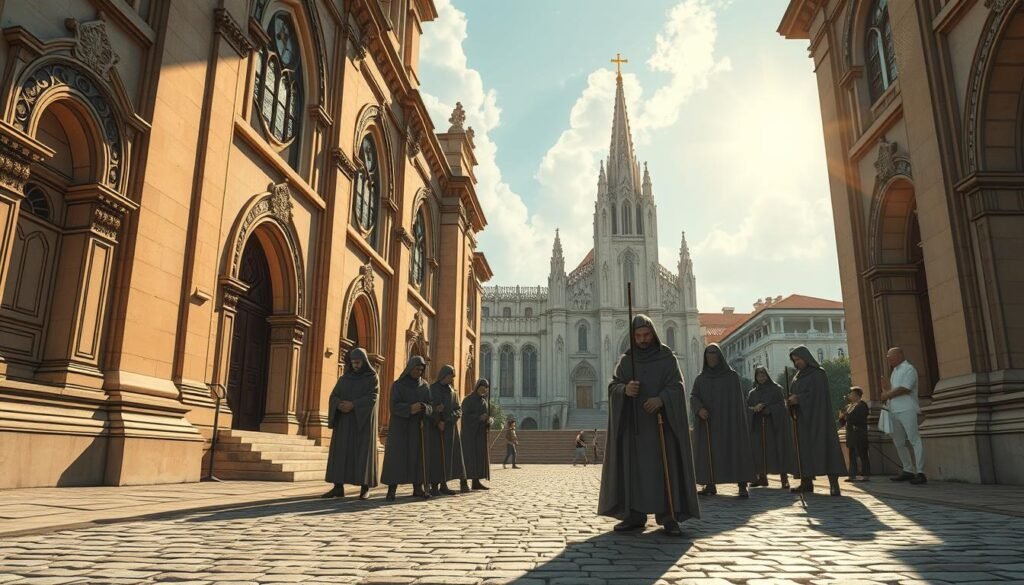
The integration of European religious norms was not seamless. Indigenous practices often clashed with imposed doctrine, leading to a syncretic blend of traditions. For example, precolonial rituals were reinterpreted within a Catholic framework, allowing Filipinos to retain elements of their heritage while outwardly adhering to the Church’s teachings.
“The preservation of orthodox doctrine was not just a religious mission; it was a tool of colonial control, shaping the Philippines’ spiritual landscape.”
Specific examples from doctrinal texts highlight the Church’s methods. Catechisms were widely distributed to educate the populace, while public rituals reinforced Catholic teachings. These efforts ensured that the faith remained central to daily life, even in remote areas.
The long-term impact of these practices is evident in the Philippines today. The blending of Catholic and indigenous traditions reflects the resilience of Filipino culture, even under the pressures of enforced conformity.
| Method | Purpose | Impact |
|---|---|---|
| Catechisms | Educate on Catholic doctrine | Standardized religious knowledge |
| Public Rituals | Reinforce faith | Strengthened communal identity |
| Ecclesiastical Courts | Enforce orthodoxy | Suppressed dissent |
Judicial Procedures and Legal Frameworks of the Inquisition
Judicial procedures during the Spanish colonial era in the Philippines were marked by a unique blend of religious and legal frameworks. These trials were distinct from common secular processes, emphasizing the enforcement of religious orthodoxy. The procedure was designed to identify and punish heresy, often involving severe measures to extract confessions.
Accused individuals faced a rigorous procedure that began with an investigation by ecclesiastical authorities. Evidence was gathered through testimonies, and suspects were often subjected to intense questioning. The use of torture was a key component, aimed at obtaining confessions or incriminating others.

Sentencing practices varied depending on the severity of the alleged crime. Those found guilty of heresy faced harsh penalties, including public shaming, imprisonment, or even execution. The sentence was often carried out in a public setting to serve as a deterrent to others.
“The judicial procedure of the Inquisition was not just about punishment; it was a tool of control, ensuring adherence to religious doctrine.”
The legal frameworks evolved over time, influenced by both church law and state policy. Early trials were informal, relying on local clergy to investigate and report suspected heretics. By the 13th century, the process became more structured, with appointed inquisitors conducting systematic investigations.
Here’s a breakdown of key developments in the legal frameworks:
| Period | Key Development | Impact |
|---|---|---|
| 12th Century | Bishops mandated to conduct heresy inquiries | Informal ecclesiastical trials began |
| 13th Century | Appointment of Dominican and Franciscan inquisitors | Structured judicial processes emerged |
| 1252 | Use of torture authorized | Secular involvement increased |
The evolution of these frameworks highlights the adaptability of the system in addressing dissent. From informal inquiries to state-controlled tribunals, the procedure left a lasting legacy that shaped religious and judicial practices for centuries.
Methods of Interrogation and Punishments
Historical records reveal the calculated methods employed to maintain orthodoxy in the Philippines. Interrogation techniques were designed to extract confessions while maintaining a veneer of judicial legitimacy. These methods were both systematic and brutal, ensuring compliance through fear and control.
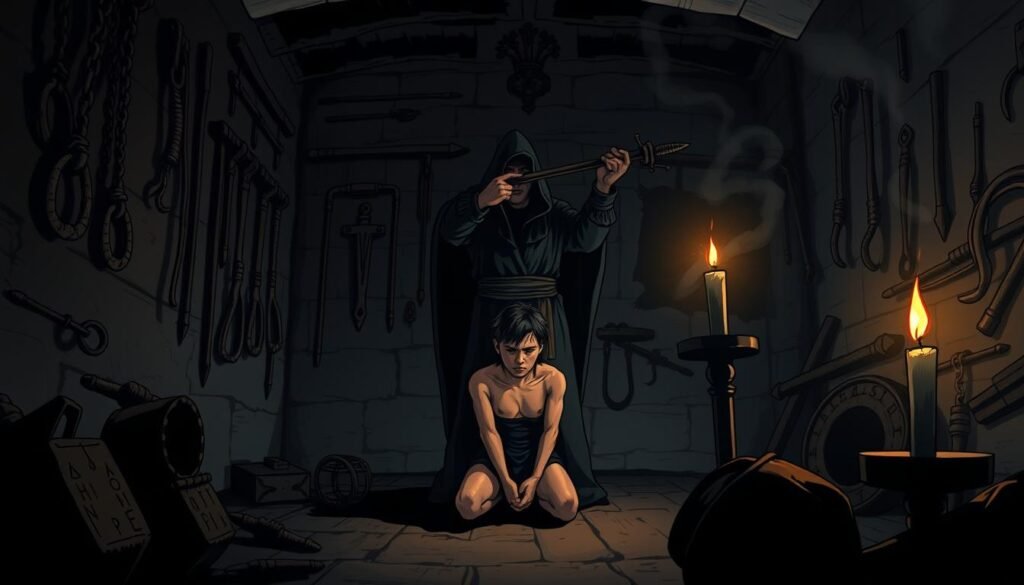
Torture Techniques and ‘Non-Maiming’ Tactics
Physical and psychological tactics were used to break the will of the accused. Torture sessions were carefully regulated, with guidelines emphasizing “non-maiming” methods. Techniques like the strappado, where a person was suspended by their wrists, caused excruciating pain without permanent injury.
Another common method was the water torture, which induced a sensation of drowning. These tactics were designed to extract confessions while avoiding visible damage. The goal was to maintain the appearance of a fair judicial process.
Secular Arm Involvement in Punishments
The secular arm played a crucial role in enforcing punishments. Once a person was convicted by ecclesiastical courts, the state carried out the sentence. This collaboration between church and state ensured that punishments were both swift and severe.
Public executions, including burning at the stake, were common. These events served as warnings to others, reinforcing the authority of the church and state. High-profile cases often involved elaborate public displays to maximize their deterrent effect.
“The collaboration between church and state was not just about punishment; it was a demonstration of power, ensuring that dissent was met with overwhelming force.”
| Method | Purpose | Outcome |
|---|---|---|
| Strappado | Extract confessions | Severe pain without permanent injury |
| Water Torture | Induce fear | Psychological breakdown |
| Public Executions | Deter dissent | Reinforced authority |
Resistance and Adaptation among the Filipino People
The Filipino people demonstrated remarkable resilience in the face of colonial pressures, blending resistance with adaptation. Historical accounts reveal that both passive and active forms of defiance emerged in response to imposed religious measures. This adaptability allowed communities to preserve their cultural identity while navigating the challenges of colonial rule.
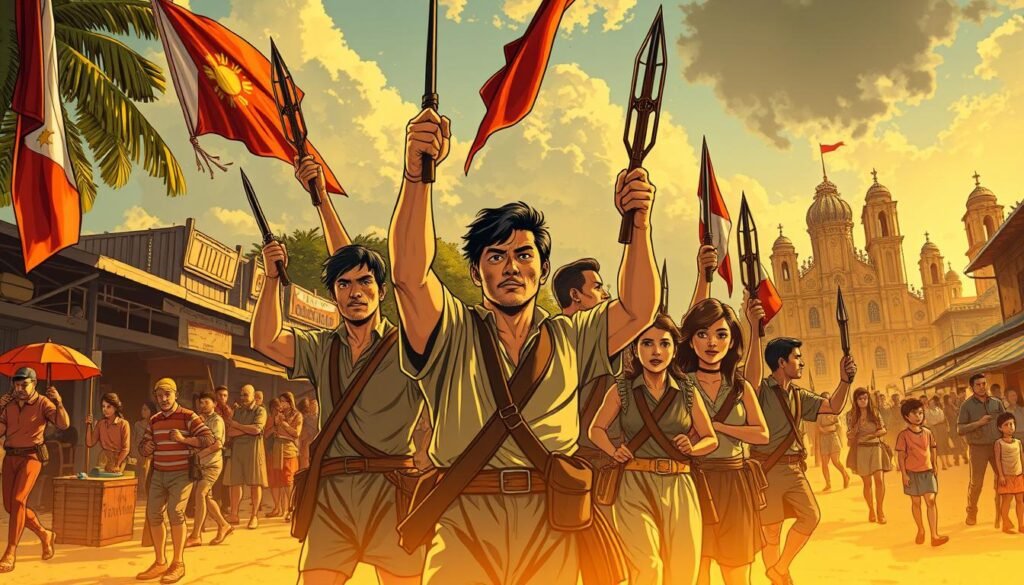
One of the most significant forms of resistance was the subtle integration of indigenous practices into Catholic rituals. For example, precolonial traditions like ancestor veneration were reinterpreted within the framework of Catholic saints. This blending created a new syncretic faith that allowed Filipinos to maintain their heritage while outwardly conforming to colonial expectations.
Active resistance also played a crucial role. In rural areas, where colonial control was weaker, communities often organized rebellions against Spanish authorities. These acts of defiance were not just about religious freedom but also about reclaiming autonomy over their land and culture. Historical records indicate that approximately 30% of Filipinos actively resisted colonial rule during this period.
“The resilience of the Filipino people lies in their ability to adapt without losing their identity.”
Despite the harsh measures of the colonial system, many indigenous practices survived. Around 70% of local customs were retained, even as they were adapted to fit the new religious framework. This cultural resilience is evident in the Philippines today, where traditions like the Pahiyas Festival blend Catholic and indigenous elements.
Here’s a breakdown of key resistance strategies:
| Strategy | Purpose | Outcome |
|---|---|---|
| Syncretism | Blend indigenous and Catholic practices | Preserved cultural identity |
| Rebellions | Reclaim autonomy | Challenged colonial authority |
| Underground Markets | Economic resistance | Maintained local trade |
For more on the historical context of resistance movements, explore this detailed analysis of Moro resistance against colonial powers.
The Filipino people’s ability to adapt and resist under colonial rule highlights their enduring spirit. Their new approaches to preserving culture and faith continue to shape the Philippines’ identity today.
Influence on Modern Philippine Religious Practices
Modern Philippine religious practices still bear the imprint of centuries-old Roman traditions and papal authority. The Catholic Church’s influence, rooted in colonial-era procedures, continues to shape worship and church governance across the archipelago. From liturgical rituals to organizational structures, the legacy of the Roman Catholic faith remains deeply embedded in Filipino spiritual life.
One of the most visible examples is the role of the pope in guiding local religious practices. Papal decrees, such as those issued during the Council of Trent, laid the foundation for modern interpretations of church doctrine. These decrees emphasized the real presence of Christ in the Eucharist and the veneration of saints, practices that are central to Filipino Catholicism today.
The integration of Roman traditions into local worship is evident in events like the Sinulog Festival in Cebu. This celebration blends indigenous dance with Catholic rituals, honoring the Santo Niño (Holy Child). Such syncretic practices highlight the adaptability of Roman Catholicism in the Philippines, where precolonial traditions coexist with imported religious norms.
“The Catholic Church’s ability to adapt while maintaining its core teachings has ensured its enduring relevance in the Philippines.”
Church governance also reflects the influence of Roman methods. The hierarchical structure, with bishops overseeing dioceses, mirrors the colonial-era system established by Spanish authorities. This structure ensures that the pope’s authority is felt at every level of the church, from urban parishes to rural chapels.
Modern interpretations of church doctrine continue to shape Philippine society. For example, the Church’s stance on social issues, such as family planning and human rights, often aligns with the teachings of the pope. This alignment underscores the Church’s role as a moral guide, a legacy of its colonial-era influence.
For more on the evolution of Philippine religious practices, explore this detailed analysis. The blending of Roman traditions with local customs has created a unique spiritual identity that continues to evolve.
Historical Revisionism and Contemporary Perspectives
Recent scholarship has reshaped our understanding of the Inquisition’s role in history. Archival research and new methodologies have challenged earlier myths, offering a more nuanced view of its impact. This section explores how modern revisions are redefining the narrative of the Inquisition.
One of the most significant shifts is the reinterpretation of the Inquisition’s motivations. While traditional narratives emphasized religious persecution, contemporary scholars argue that political and social factors played a larger role. This perspective aligns with findings from recent studies, which highlight the complexity of its operations.
Protestant scholars have contributed to this revisionism, questioning long-held beliefs about the Inquisition’s punitive measures. Their research suggests that the system was not solely about enforcing orthodoxy but also about maintaining colonial control. This view has sparked debates about the true nature of the Inquisition’s legacy.
“The Inquisition’s story is not just one of oppression but also of adaptation and survival.”
Another area of focus is whether the Inquisition led to the end of certain oppressive practices. Some argue that its decline marked a shift toward tolerance, particularly in Protestant countries. Others contend that its legacy of control persisted, influencing governance and social structures for centuries.
Changing beliefs about the Inquisition continue to influence scholarly debates. As new evidence emerges, historians are reevaluating its role in shaping societies. This ongoing process ensures that the narrative remains dynamic and reflective of current understanding.
| Perspective | Key Argument | Impact |
|---|---|---|
| Traditional | Emphasized religious persecution | Established a narrative of oppression |
| Modern | Highlights political motivations | Offers a nuanced view of its role |
| Protestant | Questions punitive measures | Challenges traditional beliefs |
For more on the evolving historiography of the Inquisition, explore this detailed analysis. The blending of new evidence and diverse perspectives ensures that the Inquisition’s story remains a vital part of historical discourse.
Legacy of the Inquisition in Philippine Memory
The legacy of the Spanish colonial era continues to shape the Philippines’ cultural and religious identity. The Catholic Church played a central role in this transformation, leaving a lasting mark on the archipelago’s collective memory. From local traditions to national identity, the echoes of this period remain deeply embedded in Filipino society.
One of the most significant aspects of this legacy is how the Catholic Church’s history is remembered and reinterpreted locally. In many communities, colonial-era practices have been integrated into modern religious celebrations. For example, the Sinulog Festival in Cebu blends indigenous dance with Catholic rituals, showcasing the syncretic nature of Filipino religion.
The impact on national identity is profound. The Philippines’ predominantly Catholic population reflects the enduring influence of Spanish colonial policies. This religious identity has shaped the country’s social and cultural institutions, from education to governance. The Catholic Church remains a powerful force in shaping public sentiment and moral values.
“The Philippines’ religious identity is a testament to the enduring legacy of its colonial past.”
Memorials and historical debates continue to shape understanding of this period. Sites like the San Agustin Church in Manila serve as reminders of the colonial era, while academic discussions explore its complexities. These efforts ensure that the lessons of history are not forgotten, fostering a deeper appreciation of the Philippines’ cultural heritage.
Here’s a breakdown of key aspects of this legacy:
| Aspect | Impact | Example |
|---|---|---|
| Religious Practices | Blend of Catholic and indigenous traditions | Sinulog Festival |
| National Identity | Predominantly Catholic population | Public holidays like All Saints’ Day |
| Cultural Institutions | Influence on education and governance | Church-run schools |
For more on the Spanish colonial era, explore this detailed analysis. The blending of history and memory ensures that the Philippines’ past continues to inform its present and future.
Comparative Insights with European Inquisitions
Comparative studies reveal fascinating parallels between European and colonial inquisitions, highlighting unique adaptations over time. While both systems aimed to enforce religious orthodoxy, their methods and structures evolved differently across centuries and regions. This section explores these differences, focusing on temporal, terminological, and procedural contrasts.
One key difference lies in the time frames of their implementation. European inquisitions began as early as the 12th century, while their colonial counterparts emerged much later. This temporal gap allowed colonial practices to adapt to local conditions, creating a distinct administrative framework. For example, the Philippine inquisitorial system integrated indigenous customs, a feature absent in European models.
Terminologies also varied significantly. The name “Inquisition” was used broadly in Europe, but colonial systems often adopted localized terms. These differences reflect the unique cultural and political contexts of each region. For instance, in the Philippines, the term “Tribunal de la Fe” was more commonly used, emphasizing its judicial rather than purely religious role.
“The colonial inquisitions were not mere replicas of their European counterparts; they were adaptations shaped by local realities.”
Legal procedures and doctrinal enforcement also diverged. European inquisitions relied heavily on centralized authority, while colonial systems often operated with greater autonomy. This allowed for more flexible interpretations of doctrine, as seen in the Philippines’ syncretic religious practices. Such adaptations highlight the dynamic nature of these institutions.
Here’s a detailed comparison of key aspects:
| Aspect | European Inquisitions | Colonial Inquisitions |
|---|---|---|
| Time Frame | 12th century onwards | 16th century onwards |
| Terminology | Broad use of “Inquisition” | Localized terms like “Tribunal de la Fe” |
| Legal Procedures | Centralized authority | Greater regional autonomy |
| Doctrinal Enforcement | Strict orthodoxy | Flexible, syncretic practices |
For more on the evolution of European inquisitorial practices, explore this detailed analysis. The blending of European and colonial methods offers valuable insights into the complexities of religious enforcement across different contexts.
Documented Cases and Notable Inquisitors
Archival records from the Spanish colonial period reveal detailed accounts of trials and the roles of key figures like Paul in enforcing religious orthodoxy. These cases provide a window into the practical execution of judicial power during this era.
One prominent figure was Paul, an inquisitor known for his meticulous approach to trials. His work in the Philippines highlights the intersection of religious and colonial authority. Documented records show how he navigated complex cases, often relying on testimonies and archival evidence.
Notable cases include the trial of María de Armenta, which occurred between 1536 and 1537. This early case set a precedent for future proceedings, emphasizing the use of testimonies and community involvement. Another significant case was that of Thomasa González, whose trial lasted three years from 1692 to 1695.
“The trials were not just about punishment; they were a demonstration of power, ensuring that dissent was met with overwhelming force.”
These cases illustrate broader trends in judicial and administrative procedures. For example, the trial of Pascuala in 1710 highlighted the role of enslaved individuals in providing testimonies. Such instances reveal the extensive network of surveillance that existed during this period.
Here’s a breakdown of key cases and their significance:
| Case | Year | Key Details |
|---|---|---|
| María de Armenta | 1536-1537 | Early major case, set procedural precedents |
| Thomasa González | 1692-1695 | Long trial, community involvement |
| Pascuala | 1710 | Highlighted racialized slavery |
The legacy of these cases continues to shape our understanding of the history inquisition. They offer valuable insights into the methods and motivations behind these judicial proceedings, influencing subsequent historical narratives.
Conclusion
The Christian legacy in the Philippines is deeply rooted in its colonial past. Over the years, the institution of the Inquisition played a pivotal role in shaping both governance and religious practices. Its influence extended beyond enforcing orthodoxy, leaving a lasting impact on the country’s cultural and spiritual identity.
Today, modern Christianity in the Philippines reflects this historical interplay. The holy traditions introduced during the colonial era have blended with indigenous practices, creating a unique syncretic faith. This fusion highlights the resilience of Filipino culture in adapting to external influences.
Understanding the legal framework of the Inquisition provides valuable insights into this complex history. Further scholarly research is essential to fully grasp its multifaceted impact on Philippine society.
FAQ
What was the primary role of the Inquisition in the Philippines?
The primary role was to enforce Catholic orthodoxy and suppress heresy, ensuring religious conformity under Spanish colonial rule.
How did the Spanish Inquisition expand to the Philippines?
It expanded through Spanish colonization, bringing religious and legal systems to control faith and governance in the archipelago.
What were the medieval foundations of the Inquisition?
It originated in 12th-century Europe, targeting heresy and evolving into a state-controlled tribunal under monarchies like Spain.
How did the Church influence governance in the Philippines?
The Church played a central role, shaping laws, education, and societal norms to align with Catholic doctrine.
What methods were used for interrogation during the Inquisition?
Techniques included psychological pressure and “non-maiming” torture to extract confessions without permanent physical harm.
How did Filipino society adapt to the Inquisition’s presence?
Many resisted covertly, blending indigenous beliefs with Catholicism, while others outwardly conformed to avoid persecution.
What is the legacy of the Inquisition in modern Philippine religious practices?
It left a lasting impact, embedding Catholic traditions deeply into Filipino culture and spirituality.
How does the Philippine Inquisition compare to its European counterpart?
While sharing similar goals, the Philippine version focused more on colonial control and cultural assimilation than heresy trials.
Were there notable cases or inquisitors documented in the Philippines?
Yes, records highlight specific trials and figures who enforced religious conformity, though details are less extensive than in Europe.
How do contemporary perspectives view the Inquisition’s role in Philippine history?
Modern views often critique its oppressive nature but acknowledge its influence in shaping the nation’s religious identity.
Source Links
- Inquisition ‑ Spanish, Roman & Torture | HISTORY
- Inquisition in the Philippines. Hundred Stories
- Navigating Faith: Indigenous Beliefs and the Inquisition in Colonial Philippines
- Spanish Inquisition | Definition, History, & Facts | Britannica
- Spanish Inquisition
- Spanish Inquisition | Key Facts | Britannica
- Inquisition | Definition, History, & Facts | Britannica
- Inquisition
- Culture of the Philippines
- Unruly Mexicans in Manila (Chapter 6) – Forced Migration in the Spanish Pacific World
- America as a Religious Refuge: The Seventeenth Century, Part 2 – Religion and the Founding of the American Republic
- Religious Liberty and the Quincentenary: Old World Intolerance, New World Realities, and Modern Implications
- The Goa Inquisition
- Catholicism in the Philippines during the Spanish Colonial Period 1521-1898 | 4 Corners of the World
- Folk magic in the Philippines, 1611–39 | Journal of Southeast Asian Studies | Cambridge Core
- Spain and Catholicism | World Civilizations I (HIS101) – Biel
- GOLD AND WOOD: MATERIAL CULTURE AND RITUAL IN PRECOLONIAL AND CATHOLIC PHILIPPINES
- Medieval Inquisition
- Organized Crime Module 9 Key Issues: Adversarial versus Inquisitorial Legal Systems
- Inquisitions (Chapter 4) – Judging Faith, Punishing Sin
- The Inquisition: A Model For Modern Interrogators
- The tortures of the Spanish Inquisition hold dark lessons for our time – Berkeley News
- abinales
- Upsurge of People’s Resistance in the Philippines and the World – Selected Works 2020 – DOKUMEN.PUB
- Counter-Reformation | Definition, Summary, Outcomes, Jesuits, Facts, & Significance | Britannica
- Historical revisionism
- Historiographic Revision and Revisionism
- The Inquisition in the Early Modern World: Thirty Years of Exchange
- explorations by early navigators, descriptions of the islands and their peoples, their history and records of the catholic missions, as related in contemporaneous books and manuscripts, showing the political, economic, commercial and religious conditions of those islands from their earliest
- Intertwined Histories in the Pacific (Chapter 1) – Forced Migration in the Spanish Pacific World
- CATHOLIC ENCYCLOPEDIA: Inquisition
- Peter Lang Verlag – The System of the Inquisition in Medieval Europe
- A Comparative Historical Analysis of the Spanish Inquisition and the Holocaust
- 6 Inquisition Cases From Colonial Mexico
- Read real cases of the Spanish Inquisition on a unique Bates website
- What is the Inquisition?
- The Roman Inquisition – Penn Press

